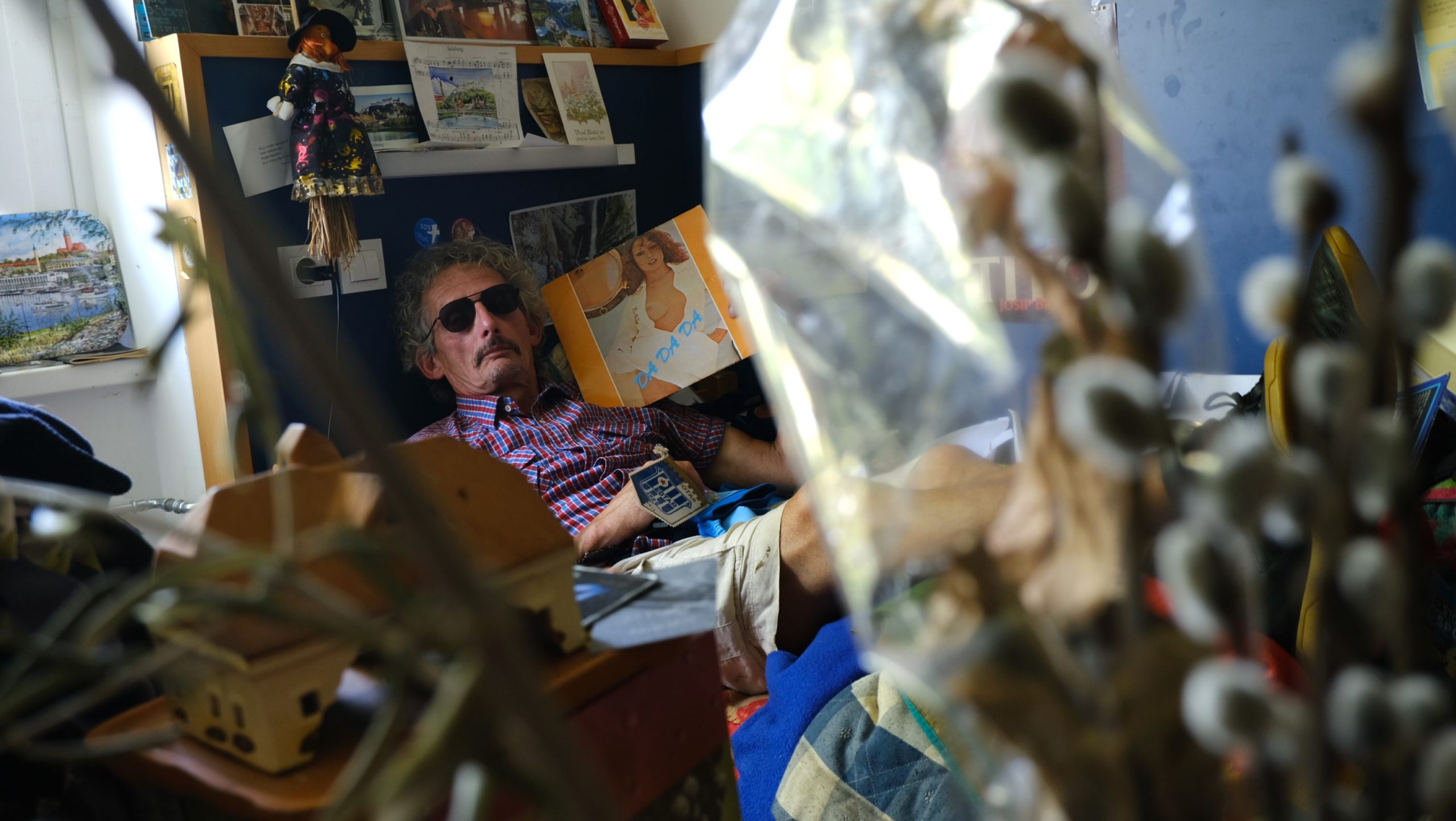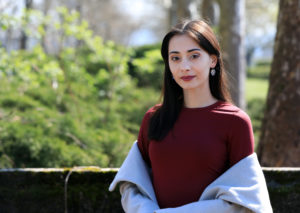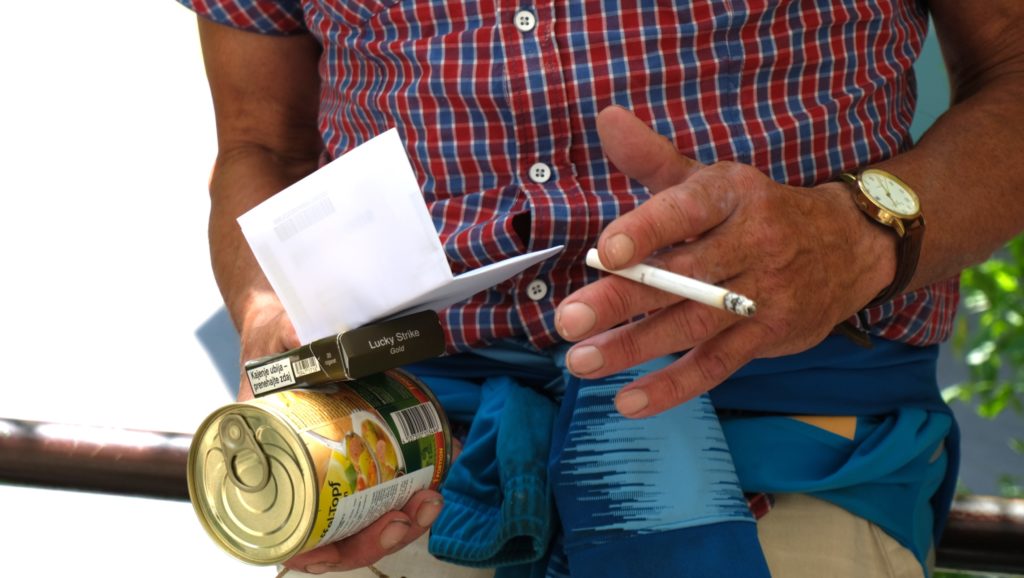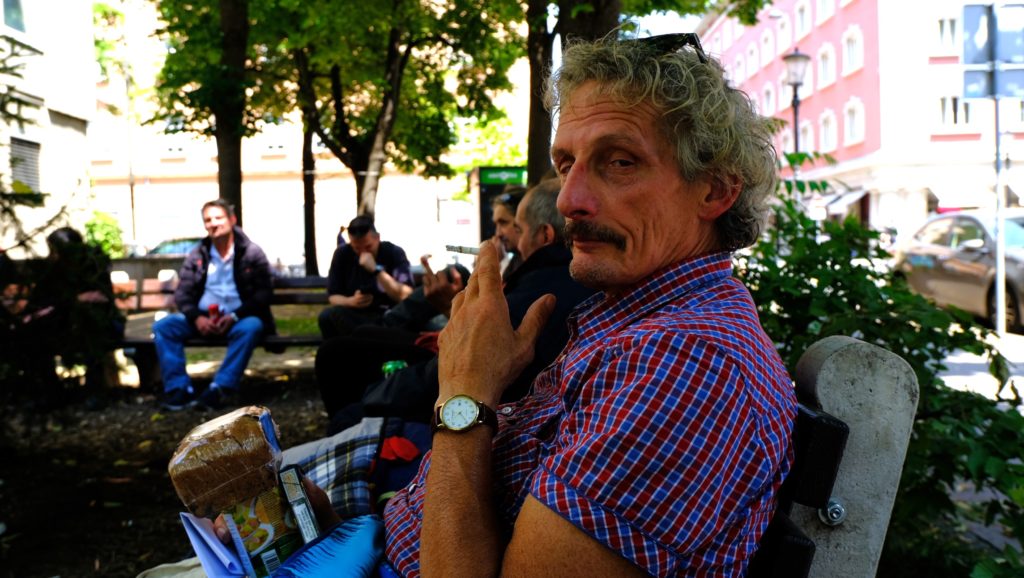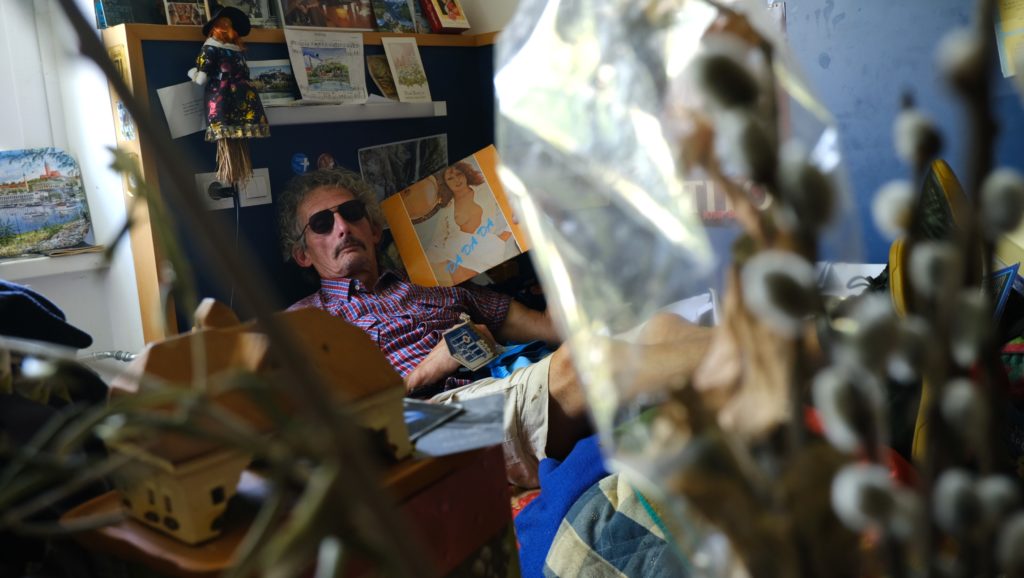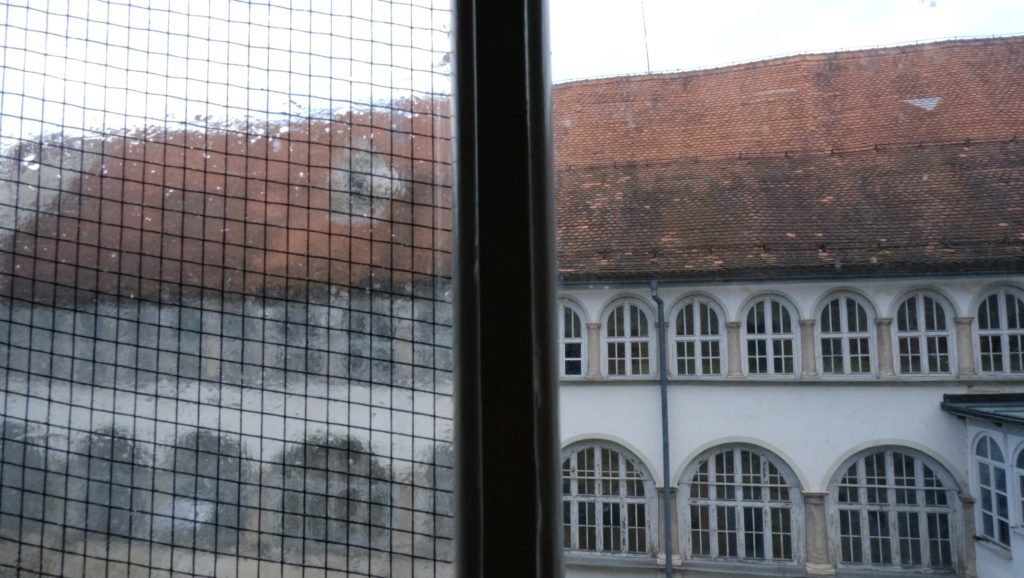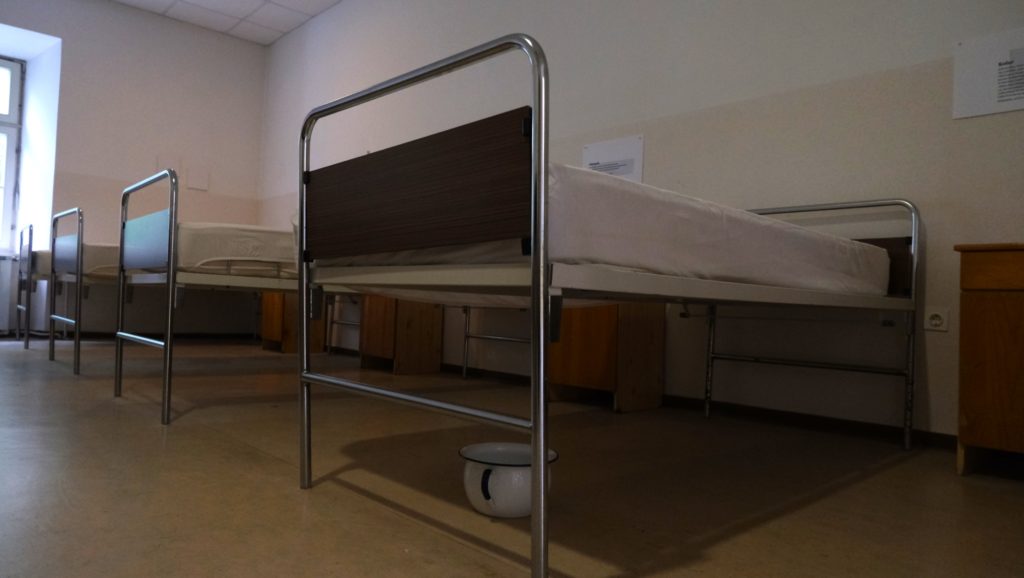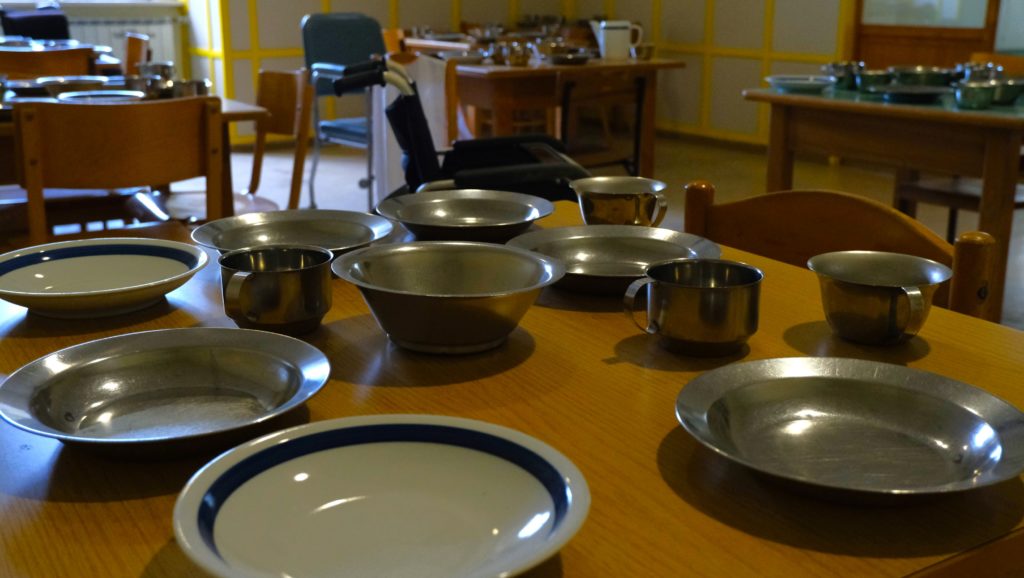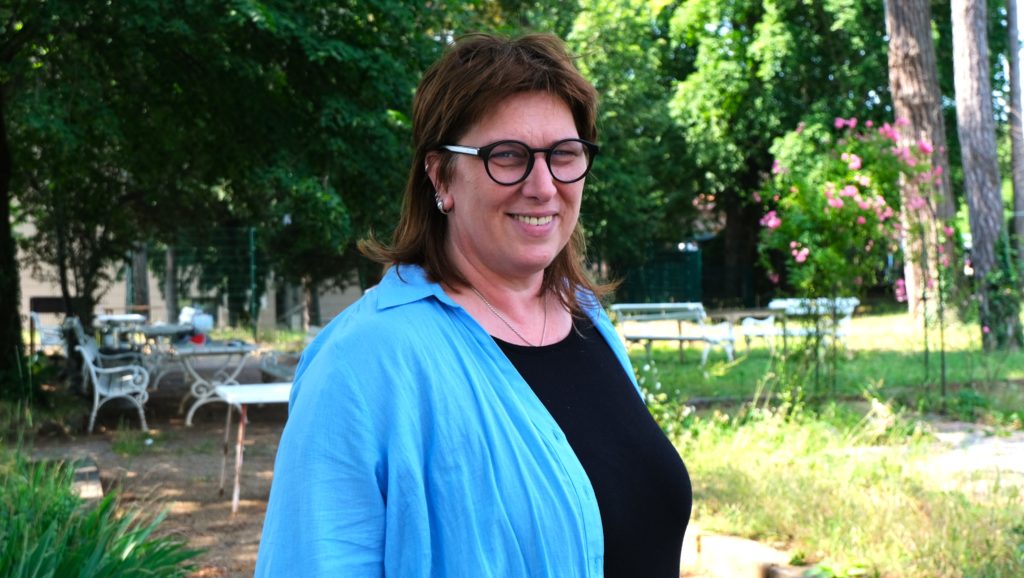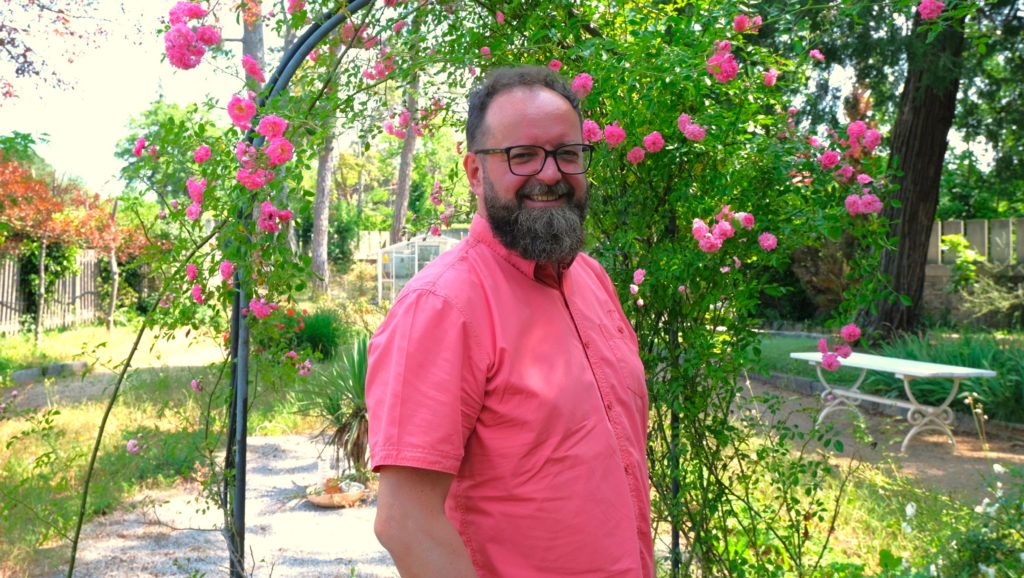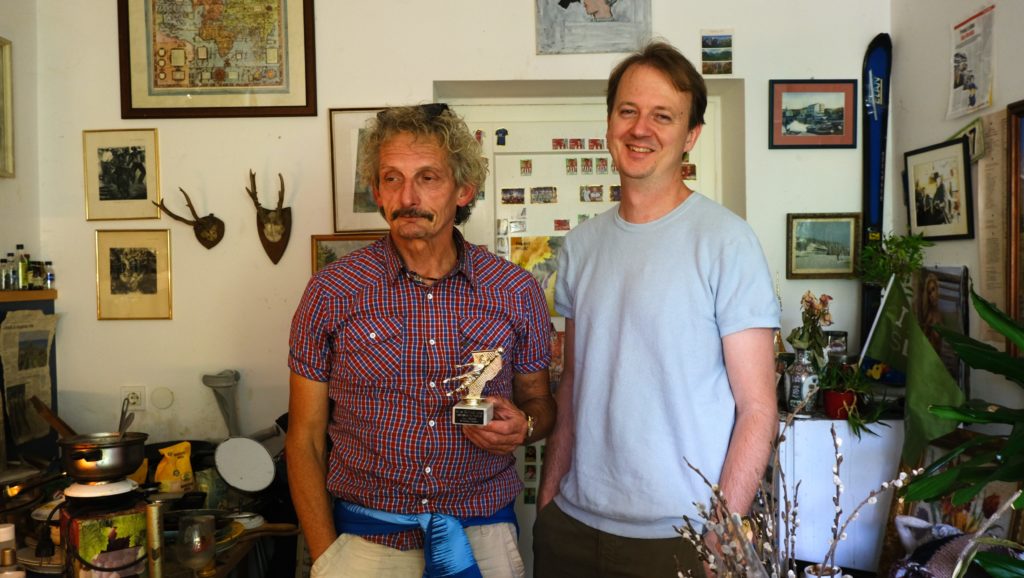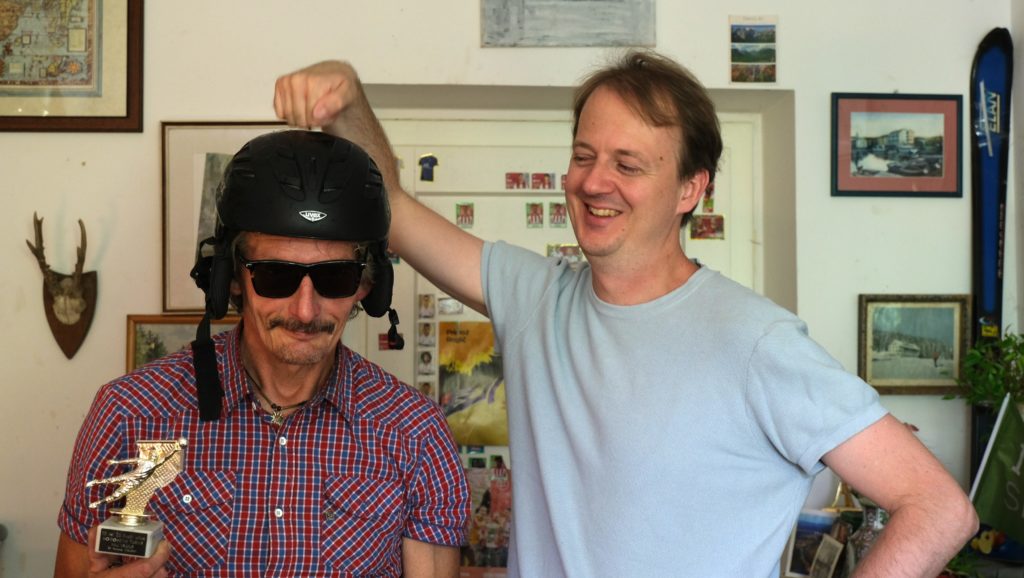24-hour confinement, hours of restraint, violence, isolation, infantilisation... this is the reality for many people suffering from mental disorders in Slovenia. For some years now, the country has been trying, to an extent, to change the way it deals with mental health. But what are the results? Patients, relatives and carers tell their stories.
Fifty-nine-year-old Joc Podlesnik, holds a cigarette between his middle and index finger as we stroll along Prešeren Square ‒ perhaps the most beautiful square in Ljubljana. While his close friend Andraž Rožman, a writer, journalist and activist, and I chat along the way, Joc follows at a little distance behind. Every now and then he wanders off and then rejoins us, greets an old acquaintance, lights up a new cigarette, fetches a tin of food from who-knows-where and stops to make a phone call. The unusually hot summers that Ljubljana has experienced in recent years don’t bother Joc as he travels around the city. To escape the heat, which can leave people feeling breathless and exhausted, he swims in the Ljubljanica river. This city and these streets are his home, every time he has been forced to leave them, through the course of his life, he has suffered.
King of the streets
We are heading to the headquarters of the organisation Kralji ulice – “Kings of the Street” – dedicated to people in need, which publishes its own newspaper. By selling this newspaper, which costs one euro, many addicts, homeless, or mentally ill people can earn a living in Slovenia. Outside the organisation’s building, a large number of people, mostly men, are gathered. They either come here to sell newspapers or to seek solace. At the moment, Joc is not one of the sellers, but he visits the organisation regularly. There are friends he enjoys meeting at Kralji ulice, and he feels safe here. Today, he will also receive a free pass to an upcoming basketball game, which for a passionate fan like Joc, is “an absolute necessity”!
"When I was first admitted in 1982, they washed me like a pig with cold water from a black hose."
As a young boy, Joc wanted to study history and geography. He was drawn to exotic countries, foreign cities and other worlds. After he was diagnosed with paranoid schizophrenia and admitted to a psychiatric ward, his plans fell through. “When I was first admitted in 1982, they washed me like a pig with cold water from a black hose,” he recalls. “The scariest part was when you had to undress. Two huge men, who were medical technicians, escorted you to the changing room. If you were too slow, you could be hit,” he explains with a tone of resignation in his voice.
“Joce’s story is, first and foremost, a testimony about the history of our mental health system,” Andraž comments. “But it is also a story about the present: the conditions in psychiatric and closed institutions have not changed much to this day. Only the methods are slightly different,” he adds.
Lawful violence
Andraž is not surprised to hear about the inhumane conditions in which people with mental health issues have lived ‒ and continue to live ‒ in Slovenia. In this country, by comparison to other EU member states, deinstitutionalisation started late and at a slower pace. For instance, the process was at its height in Italy in 1980 and admittance to institutions was banned by law. In this neighbouring country, people with severe and chronic mental health disorders were cared for in several regional mental health centres, a move which was not mirrored across the border, in Slovenia.
The rhetoric justifying the decision not to begin deinstitutionalization claimed there were numerous faults in the deinstitutionalization process and possible negative effects, such as a supposed increase in homelessness and the lack of care for psychiatric patients. To this day, no institution in Slovenia has been fully closed and the majority of care for people experiencing mental distress is still provided by institutional care, while there are fewer frameworks for communal living and community-based services. What’s more, the long-stay institutions and institutional units are even growing or being renovated. Even though protocols are available, there remain limited opportunities for re-settlement in the community.
"People come to psychiatry frightened, distressed and often expressing themselves through aggression"
As an activist and writer, who also explores mental health issues in his documentaries, Andraž has heard dozens of stories similar to Joce’s, he tells me. Some of the violence in psychiatric hospitals is legal ‒ such as being tied up for four hours – and some is not, but still exists ‒ such as excessive restraints, for up to ten days, intentional dehydration and genital beatings. “People come to psychiatry frightened, distressed and often expressing themselves through aggression. In return, they get coercion and violence. Medication is provided, but there’s not nearly enough talk-based therapy,” Andraž continues.
A career as a madman
When Joc began his “career as a madman”, as he describes it, there were other methods, such as electroshock and insulin therapy. Those methods are no longer implemented, but the violence, however, continues. Andraž, who works daily with people who have lived or are living in these institutions, says: “Workers often treat people not as subjects but as objects, without believing that the will of the person concerned means anything. To change this, a fundamental shift in thinking and in the system is needed.”
Joc is a very thoughtful man. As we walk to his apartment on the other side of Ljubljana, he discusses climate change, football, antique sales and fishing. His many interests are evident in his very cluttered room, which is difficult to enter due to the abundance of objects. The walls are covered with photographs of famous sportsmen and women and imitations of works of art. The shelves are lined with books, magazines and photo albums containing pictures of people, some of whom Joc no longer has contact with. When they don’t meet in the centre of Lubjana for a coffee and croissant ‒ Joc’s favourite dessert ‒, this is where Andraž and Joc spend time together.
“When it comes to housing, Joc is always on edge”, says Andraž sitting in his friend’s room. He lived in his own apartment for a while, then was placed in a group home of the Slovenian Association for Mental Health (ŠENT) and ended up homeless for a short time. In 2017, he moved into a Ljubljana Housing Fund apartment ‒ his current accommodation ‒ which is an “institution without staff”. If you are a citizen of Ljubljana, you can apply for accommodation in public housing. If you meet the eligibility criteria (including unemployment, disability, social vulnerability) you can expect your application to be approved. However, this is not a place where mentally disabled people, including those who have been in institutions for a long time, receive any support with daily tasks they may not be able to do for themselves, physical care if they need it, or any therapy they may still need.
Since the authorities say that Joc is not following the rules (although he strongly disagrees with this statement), he now has to move out.
The building, with its long white corridors and shared bathrooms, is home to people from all backgrounds (people with mental health issues, homeless people… people who have perpetrated violence and people who have been victims of violence). All residents may come and go as they wish, but they have to abide by a set of rules ‒ including no visitors after 10pm. Since the authorities say that Joc is not following the rules (although he strongly disagrees with this statement), he now has to move out. There is a chance he could end up back on the streets, and although Joc is one of the few who has managed to leave institutional care ‒ at least to some extent ‒ his life could have been different with the right support.
The provision of adequate support in Slovenia is still in its primary stages and closed institutions have a long history. Andraž recalls one of the first institutions (or branches of the institution) to be closed down in Slovenia ‒ the Trate Institute, which operated in Cmurek Castle from 1949 to 2004 (which is part of the larger Hrastovec Institute, which operates several branches, some of which are still active today). At first, the Trate Institute was reserved for the seriously ill and infirm (who were also impoverished and often without relatives) and later for the neurologically and mentally ill.
Museum of Madness
The castle is located right on the Austrian border ‒ the Mura River, which has been the national border for the past 100 years, runs underneath the walls. Darja Farasin and Sonja Bezjak are residents of Trate. They grew up near the institute where 350 patients were living 24 hours a day, at that time. As we march through the great, cold castle, Sonja recalls: “The residents of the institution would sometimes walk around the village, but there was no significant contact between them and the locals.” When rumours that the facility would be closed began to circulate, local people feared for their jobs there. In the end, the workers from Trate did not lose their jobs. They now have to commute to work in the surrounding towns in other branches of the Hrastovec Institute. 20 years after the closure, Sonja says happily: “We can be proud that the first ‘total institution’ in Slovenia was closed in 2004, right here in Trate.”
To prevent the castle from falling into disrepair ‒ and to learn from recent history ‒ the former “patient wards” have now been turned into a ‘Museum of Madness’. Sonja is its director. She is very passionate about the running of the museum – a job she does on a voluntary basis and without pay. “This is our legacy, and with the museum that operates here today, we want to raise awareness and help make sure that the human rights of the many people who still live in institutions today are respected. We have to reject institutions,” she continues.
The creation of institutions, like the one in Trate, began with industrialisation, when people started working outside the home and were no longer able to care for their disabled relatives. During the Nazi occupation of Slovenian Styria in 1941, many mentally ill people were executed (around 600 people with disabilities from Slovenian Styria were taken to death camps to Austria), and after the war, castles and mansions were nationalised and many became places of institutional care (orphanages, hospitals, homes for the elderly and disabled, etc.). Because people were unidentifiable, the documents left in Trate testify that they were given names such as “the Mutant Woman”, or “the deaf and dumb Julka”, and so on.
Until 1970, the Trate Institution resembled a more ‘traditional’ communal lifestyle ‒ people, then called ‘patients’, worked in the fields and stables. Standards rose under socialism as the state concluded that people could not live in such conditions, so central heating and toilets were built and the first trained nurses were employed. “The sanitary conditions were disastrous. The nurses brought knowledge to the institution. Field work was also abolished because it was perceived as exploitation. But surviving without work was harder in its own way ‒ 350 people were now trapped behind the walls,” her colleague Darja continues. The rooms still bear witness to the state of the institution just before it was closed. The windows were frosted, so the patients couldn’t see the outside. In the dining room there were no forks or knives. The dehumanised mass of people often threw food at each other and ate with their hands.
The lack of therapy was compensated for with pills, technical barriers, restraints and straitjackets.
The workers were also in dire straits ‒ some 80 or even 120 people were being looked after at night by just one or two carers. The lack of therapy was compensated for with pills, technical barriers, restraints and straitjackets. The women were particularly vulnerable. Some of them, having been abused before entering the institution, were subjected to forced sterilisations and contraceptives, abortions and the removal of their children. Suitcases and all the things that had been forcibly taken from people, were left behind in the castle. Sonja told a story about a patient who loved to help in the fields and never took off her rubber boots, even at night when she slept. The workers eventually accepted this because she was perceived as “crazy” anyway. When she died it was discovered that she had hidden money in them. She was prepared to do anything to have something ‘of her own’.
The staff were not happy either with the way people were being looked after, says Sonja, who, together with her colleagues, collected testimonies from former employees of the institution. They found the lack of hygiene and the overworked staff particularly worrying. However, because they worked hard and to the best of their ability, disapproval towards the institution – as it stands today – hurts them in its own way. At the same time, they have internalised the idea that what they did was the best that could be done – and in that sense, the right thing to do.
While in many other countries, the process of deinstitutionalization has been going on for a long time, in Slovenia, institutions are still robust. Today, around two thousand seven hundred people live in special institutions and about seven hundred in closed wards, as stated in the Deinstitutionalisation Strategy, an internal document of the Slovenian Ministry of Social Affairs. Current legislation allows for a further increase in the number of beds, in contravention of European Union guidelines and the International Convention on the Rights of Persons with Disabilities.
Back to the community
With the help of two European-funded projects, things have started to move in a more positive direction. One of them involves moving residents from the institutional care facility Dom na Krasu in Dutovlje, in the region of Primorska ‒ on the border with Italy ‒ to community-based homes. This project marks the beginning of the end of the ‘total institution’ in this part of Slovenia. Promoting and safeguarding the dignity and respect of users of its services (adults suffering from long-term mental health problems and adults with developmental and mental disorders) is at its heart. There, these adults will be equipped with the right skills and support in order to help them reintegrate into the community and live as independently as possible, despite their issues and challenges. The project, worth 2.2 million euros, will be co-funded by the European Social Fund, with the contribution from the Fund standing at nearly 1.8 million euros.
In Dutovlje, the history of moving people goes back to the opening of the first residential group in 2003. So far 171 people have been moved out of institutions to group homes where they live in smaller groups and are better integrated into the local community. Instead of living in separate, closed facilities, they live in group homes, on their own, or in very small groups of people, making their own schedules, getting back to work, pursuing their hobbies and, last but not least, having the family and intimate life they were deprived of when they were institutionalised. Meanwhile, the staff of the (disappearing) institutions continue to help them with the daily tasks they cannot do for themselves.
"There should be no punishment without a crime ‒ but we are criminalising mental distress, we are removing the unproductive to keep the streets clean"
Urška Sorta Kovač is sitting in the garden under the linden tree in front of the Dom na Krasu institution, which is becoming less and less crowded by the day. She has been working here since 1996 and is one of the most qualified people in the country in her field. Despite the recent progress, she argues that “Slovenia is still a very institutionalised society. There should be no punishment without a crime ‒ but we are criminalising mental distress, we are removing the unproductive to keep the streets clean”. The slow path towards deinstitutionalization is merely symptomatic of Slovenian society’s past choices. And yet, Urška argues, when residents are moved to open communities, things change on many levels.
The lives of both residents of group homes and staff are different from then on, says Urška. Residents have forgotten a lot, after their time in institutions ‒ they need time to get used to their new surroundings. First of all, there is a period of recovery, because moving is a stressful experience for everyone. The staff, on the other hand, have to make a big change in their way of thinking. “It is not only the residents who are institutionalised, but also the staff. They have to look after people in a different and much more personal way, according to the individual’s needs. It’s a shift of routine ‒ the real needs of the person, which have been hidden for years, come to the surface,” she explains. That’s what Urška Sorta Kovač does on a daily basis – she helps people to formulate and achieve their goals (even if it’s just to go to the cinema), she gives them psychological support for each step.
Unlike in the past, people are allowed to shape their own daily lives – and those daily lives are, for the most part, no different from the lives of people without disabilities. Joc has not been able to live in a supported but non-institutionalised, home – if that were the case, he would be able to re-enter the workforce in mid-life and secure a more stable income, which he has never had. This has consequences even today, where he lives in uncertainty about where he will sleep tomorrow. “It’s not just about living alone or in small groups. It is about taking an active part in your own life and having a say in the work processes,” Urška continues. One of the most important developments they are introducing is the involvement of users, including their participation in all working groups, up to and including management.
Deinstitutionalisation and reintegration
Dialogue with the community is also crucial to successful integration into a new environment, but it is not always an easy path. The EU-founded project in Dutovlje encountered resistance from local residents. “Of course there is fear, but the question is how much it escalates and how the escalation of fear is generated. The main idea of the project is to work on all segments ‒ users, relatives, staff, the wider community,” says director Goran Blaško, who has been working here for five years and who took over at a difficult time. The work was particularly challenging during the coronavirus outbreak, when it was hard to find places to house people, Blaško explains.
The project ‒ with its deadlines and requirements ‒ also has many limitations. It has a duration of only three years. Another major problem is overcrowding and lack of space, especially for people under court orders. There have been cases where people have been forced to sleep in the corridor. “But the solution is not to increase capacity! More community work is needed”, Urška continues. Deinstitutionalisation will not end when the last person moves out of a closed institution, but rather when wider society changes its perception of this important part of our community.
The success and speed of the reintegration process depends on how long the residents have been away from the community (the average stay in special institutions is around 12 and a half years according to the Deinstitutionalisation Strategy) and on who supports them along the way. Joc has spent more than 15 years in and out of the institutions and ‘outside of society’, but when it comes to support, he has a great advantage. A book written by Andraž about his life ‒ called Titov sin, because Joc often imagined he was the Yugoslav leader’s son ‒ has given him support as well as a social network.
Pancakes and basketball
On our way out of Joc’s apartment, Andraž briefly recalls that he used to make pancakes for the people in the Dutovlje institution, which is now in a state of transition. One of the people who lived there had no teeth. He was not allowed to eat the pancakes due to the risk of choking. “He would have given anything for that pancake. He became aggressive because he was the only one who could not eat it. I wondered what to do – and I cut his pancake into very small pieces,” he recalls. Immediately, the man’s behaviour and attitude changed. “I asked him if I could make him another one. He said no, and that there should be some left for the others.” What does that tell us? “As they used to say in Trieste: freedom is therapeutic. We must open the doors of the institutions and allow independent living to flourish,” says Andraž.
After we said goodbye, Andraž and Joc went for another coffee. Joc is preparing for yet another public campaign on the importance of deinstitutionalisation in Slovenia. He is still fighting every day and Andraž is helping him as much as he can. But the fact is, that while Joc has big ambitions, life continues and at the end of the day, he still worries about where he’s going to live, what he will eat – and how that long-awaited basketball game will turn out.
This story is part of the YOUTHopia campaign, a journalistic project shedding new lights on the EU Cohesion Policy.
Desinstitutionalisation at a standstill, the Slovakian case
Over the last ten years or so, many countries in Central and Eastern Europe have embarked on the process of deinstitutionalising care for people with psychiatric disorders. However, not all countries are moving forward at the same speed. In Slovakia, the process even seems to be at a standstill, according to Vesna Švab, a Slovenian psychiatrist and professor.
Slovenia is struggling to truly deinstitutionalise mental health care. However, it is not alone, other European countries such as Slovakia, for example, find themselves in a similar situation. Slovakia officially began its deinstitutionalization process more than ten years ago and EU funds were allocated to help transition to a community based system of mental health care. Yet the results are limited. The funds were mainly used to maintain and renovate institutional structures – which has nothing to do with deinstitutionalization – or to build smaller facilities – which is still not deinstitutionalization but transinstitutionalisation. This term refers to a process whereby individuals, supposedly deinstitutionalised as a result of community care policies, in practice end up in different institutions, rather than in their homes. Although they may be different and smaller, they remain institutions and patients are not brought back to their communities.
In both Slovakia and Slovenia, the EU, patients and NGOs have complained about the situation. NGOs – like us – are advocating for the enlargement and improvement of community rehabilitation services, based around vocational rehabilitation, supported employment, housing, and community mental health centres. We also endorse community service in homes, when the situation allows.
Another barrier to deinstitutionalisation in Slovakia, is the fact that decisions regarding social care homes depend on local authorities, who aren’t all in favour, thereby slowing down any progress. Furthermore, NGOs are not adequately represented in the process, despite having the best expertise in human rights protection of people suffering from mental disorders. In Slovakia today, these small organisations are the only ones providing rehabilitation and recovery services, in other words deinstitutionalised care.
